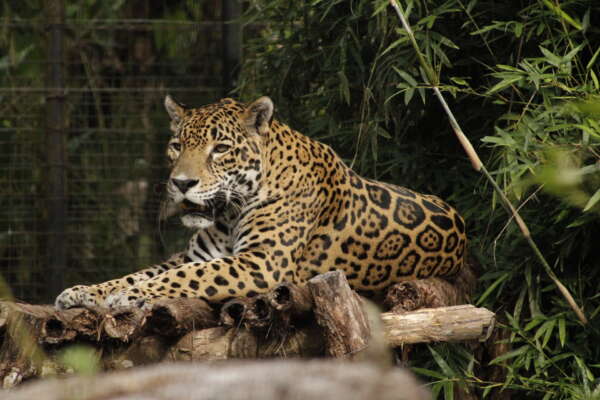
Biology
Height: 2.5 feet
Weight: 75 -150 lbs
Lifespan: 12 - 15 years
# of offspring: 1-2 cubs
Gestation period: 90 days
Range & Habitat
Habitats: Tropical broadleaf forests; lowland savanna; pine and oak woodlands; riparian forests; mangroves; montane forests
Food & Function
Lifestyle: Crepuscular; Terrestrial
Ecological roles: Apex predator; Population balance; Keystone species
Jaguar
(Panthera Onca)
Spanish: Jaguar
The Jaguar is the largest wildcat in Belize, and the third largest in the world after tigers and lions. It is the only cat in the Americas that can roar, and only have one recognized species (no subspecies) throughout its range.
Jaguars have been known to hunt 87 different types of animal in the wild, sometimes including crocodiles and tapirs. Their favourite prey in Belize are deer, peccaries, pacas, and armadillos.
They are mostly crepuscular, but have been known to be active during the day. Jaguars have excellent senses of vision and hearing; their sense of smell is also considered better than most other felines.
Black Jaguars are extremely rare in the wild, and though there are many reports of sightings in Belize, one has never been officially documented. Underneath the black fur, is the normal spotted coat that all jaguars have; they are not a different species.
Camouflage and padded paws help them to be stealthy hunters that can quietly get close to their prey before attacking.
Jaguars are a threatened species throughout their range. In Belize, loss of habitat combined with increased hunting of jaguar prey species have contributed to increased survival pressures for the jaguar population. It is estimated that 800-1,000 individuals remain in Belize. As habitat and wild prey are reduced, older and injured or sick jaguars often venture into farms and rural communities seeking food, and begin to prey on livestock and domesticated animals. This has usually results in to the animal being shot by residents in retaliation.
Fun Facts
- Jaguars have the most powerful bite of any wildcat; over 1000 PSI.
- They prefer to kill their prey with a single bite through the skull.
- The patterns on a jaguar’s coat are like human finger prints; they are always different, and can be used to tell one jaguar from the other.
- Jaguars are excellent swimmers, and even hunt in the water.
Belize Zoo Trivia
- The oldest jaguar who ever lived at the Zoo was CT; he was 23 years old
- Jaguars at the Zoo enjoy enrichment, such as perfume scented logs, blood popsicles, cardboard boxes, and boomer balls
Conservation Efforts
In an attempt to reduce the number of jaguar killings due to conflict with humans, in 2003 TBZTEC, in collaboration with the Belize Forest Department began a program to intervene on behalf of jaguars who were confirmed to be repeated livestock predators.
After assessment and authorization by BFD, the cats are humanely trapped and safely transferred to the Human Jaguar Conflict Program (HJCP) facility at the Zoo. To date, the HJCP has rescued over 20 jaguars from conflict situations and certain death.
Jaguars in the HJCP have contributed to ex-situ conservation efforts for their species. Research on veterinary medicine, hormonal studies, feeding habits, size and weight comparisons, and behaviour has been conducted. These studies have helped inform informational gaps in the study and conservation of their species in the wild.
Three jaguars have also been sent to AZA accredited zoos in the USA as part of the Jaguar Species Survival Plan.
